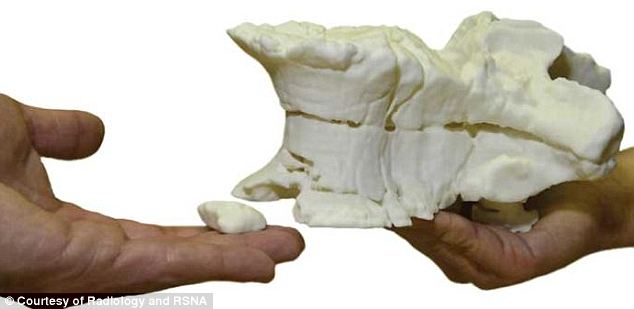German researchers employed a CT scanner and a 3-D printer to re-create a copy of a dinosaur fossil that has been wrapped up in protective plaster for decades, with the real trick being that they could accomplish such a feat without ever removing the plaster.
In this week's issue of the journal Radiology, they report that the technique could be used to study and share objects that are too rare or fragile to be moved and passed around.
"The most important benefit of this method is that it is non-destructive, and the risk of harming the fossil is minimal. Also, it is not as time-consuming as conventional preparation," said radiologist at the Charite Campus Mitte in Berlin, said in a news release from the Radiological Society of North America, Ahi Sema Issever.
Fossils are usually wrapped in plaster casts, or jackets, to protect them from damage during transport or storage. To study the fossil, researchers often have to remove the plaster as well as the sediment surrounding the specimen. However, researchers don’t always know what the plaster contains and therefore are afraid of taking a risk and damaging what’s inside the wrapping.
CT scans have been used to trace the structure of dinosaur brains, look at fossilized whale bones inside their plaster jackets, and make out the face of a 49 million-year-old spider wrapped in amber. Therefore it wasn’t too much of a hassle to apply the technique on a mystery fossil from Berlin's Museum für Naturkunde.
The fossil, concealed in its protective plaster jacket, was part of a collection that was buried beneath piles of rubble in the museum's basement after a World War II bombing raid. Some of the exhumed specimens have been difficult to identify. Therefore, Issever and colleagues took one of the unidentified chunks of plaster and put it through their CT scanner. The plaster, sediment, and fossilized bone absorbed X-rays differently, generating a clear picture of a dinosaur vertebra inside.
The researchers matched up the picture with a sketch detailing fossils from an excavation that was conducted from 1910 to 1927 in a clay pit south of Halberstadt, Germany. They could also see that there were several fractures and damage to the front rim of the vertebra.
The detailed re-construction from the CT scan was then fed into a 3-D printer, which generated an accurate reimaging of the fossil through selective laser sintering.
It's not uncommon to see reproductions of dinosaur fossils. The best-known dino-copies include plastic reproductions of Sue, the multimillion-dollar Tyrannosaurus rex skeleton that's on display at Chicago's Field Museum. But advances in 3-D printing are likely to make artificial fossils much more available and much less expensive.
"The digital dataset and, ultimately, reproductions of the 3-D print may easily be shared, and other research facilities could thus gain valuable informational access to rare fossils, which otherwise would have been restricted. Just like Gutenberg's printing press opened the world of books to the public, digital datasets and 3-D prints of fossils may now be distributed more broadly while protecting the original intact fossil,” said Issever.











